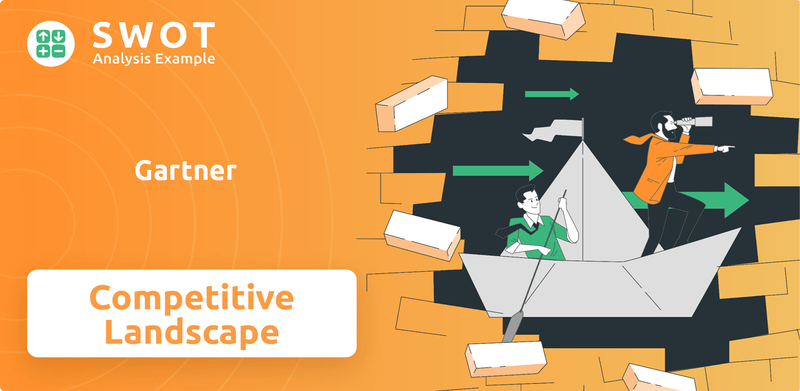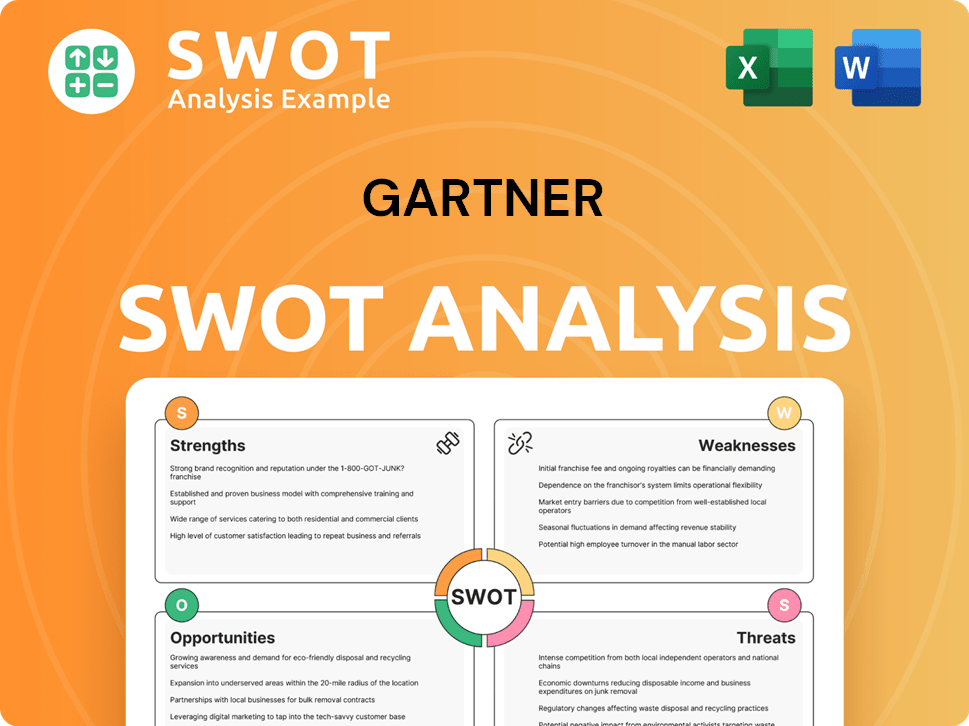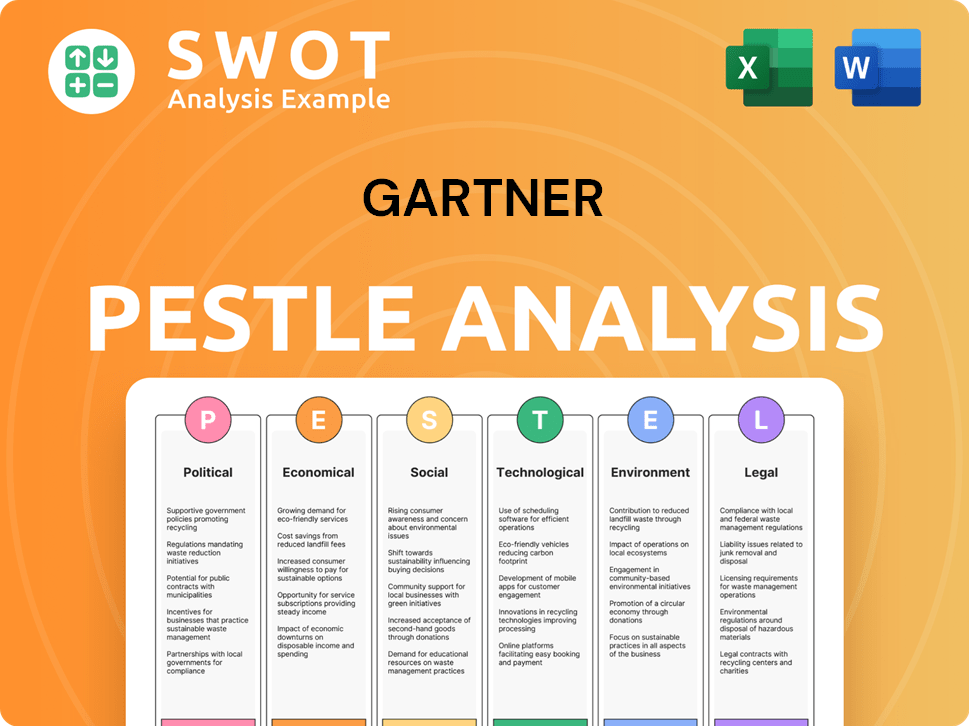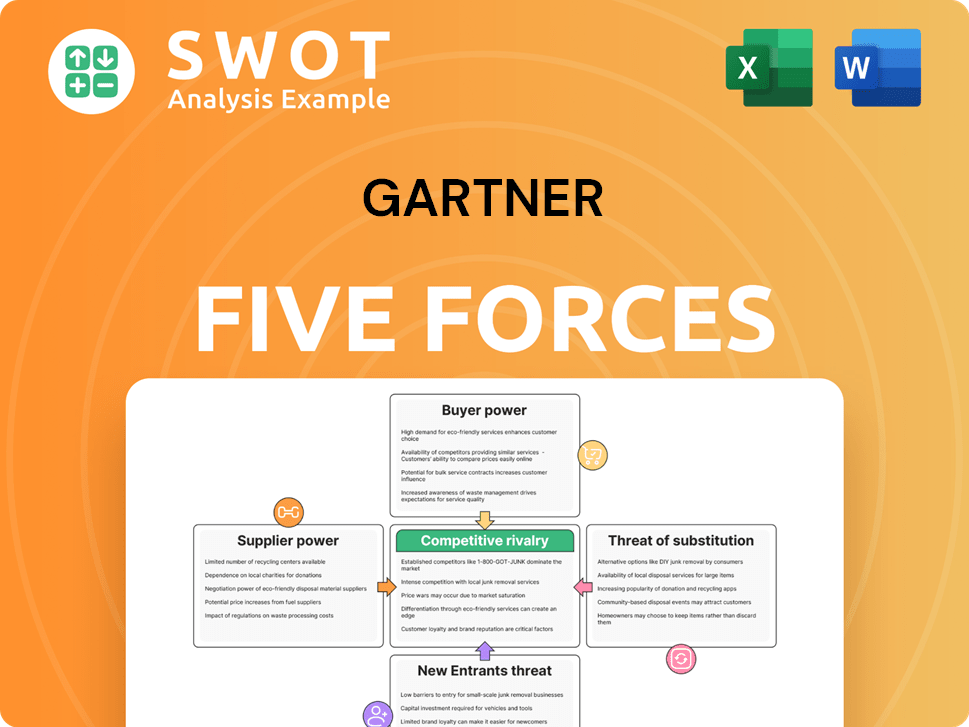Gartner Bundle
Who Dominates the Tech Advisory Arena Against Gartner?
Gartner, a titan in the research and advisory sector since 1979, shapes strategic decisions for global leaders. From its roots in IT, Gartner has become indispensable, offering critical insights across diverse industries. Understanding the Gartner SWOT Analysis is key to grasping its market position.

This deep dive into the Gartner competitive landscape will explore its rivals and its strategies for maintaining its leading position. We'll conduct a thorough Gartner market analysis, examining the Gartner competitors and how they stack up in the IT research industry. This analysis will reveal Gartner's strengths, weaknesses, and competitive advantages in the dynamic world of technology advisory firms, providing a comprehensive understanding of its market share and strategic outlook.
Where Does Gartner’ Stand in the Current Market?
Gartner holds a strong market position within the research and advisory industry, particularly in the IT sector. Its consistent revenue growth and extensive client base highlight its leadership. The company's diverse offerings, including research, executive programs, and consulting, cater to a broad range of clients.
The company's primary focus is on providing insights and advice to C-suite executives and senior leaders across various functions. Gartner's global presence and diverse customer base, from large enterprises to mid-market companies, underscore its extensive reach. The firm’s strategic expansion into areas beyond IT research reflects its aim to become a comprehensive advisory firm.
In 2023, Gartner reported revenue of approximately $5.9 billion, marking a 7% year-over-year increase. This growth demonstrates the company's robust performance and its ability to maintain a strong market position. Gartner's financial health is evident in its net income, which reached $705 million in 2023. This financial stability supports its continued expansion and investment in new offerings.
Gartner's market share in the IT research industry is significant, although precise figures can fluctuate. The company's revenue of $5.9 billion in 2023 reflects its strong financial performance and market dominance. This revenue growth indicates a solid position in the competitive landscape.
Gartner serves a global clientele, with a strong presence in North America, EMEA, and Asia Pacific. Its customer base includes large enterprises and mid-market companies. The company targets C-suite executives and senior leaders across various functions.
Gartner's primary offerings include Research, Executive Programs, and Consulting. These services cater to a wide range of executive needs. The company’s diversification into areas like HR and finance reflects its comprehensive advisory approach.
Gartner's financial health is robust, with a net income of $705 million in 2023. This financial stability supports its continued growth and investment in new areas. The firm's strong financial performance is a key factor in its market position.
Gartner's competitive advantages include its strong brand recognition, extensive research capabilities, and a large client base. The company's focus on providing data-driven insights gives it an edge in the market. To further understand the company, you can read a Brief History of Gartner.
- Strong brand recognition and market leadership in the IT research industry.
- Comprehensive research offerings covering various technology and business areas.
- Global presence with a diverse client base across different industries and company sizes.
- Consistent revenue growth and strong financial performance.
Gartner SWOT Analysis
- Complete SWOT Breakdown
- Fully Customizable
- Editable in Excel & Word
- Professional Formatting
- Investor-Ready Format

Who Are the Main Competitors Challenging Gartner?
The Gartner competitive landscape is shaped by a variety of direct and indirect rivals. These competitors challenge its market position through different strategies, including niche expertise, pricing models, and alternative research methodologies. Understanding these dynamics is crucial for assessing Gartner's market analysis and its ability to maintain its leadership in the IT research industry.
Direct competitors, such as Forrester Research and IDC, offer similar services, often targeting the same clientele of IT and business executives. Indirect competition comes from larger consulting firms and free online resources. The rise of data analytics platforms and AI-driven tools also impacts the competitive environment, potentially changing the traditional research model. For more insights, check out the Target Market of Gartner.
Gartner competitors employ varied strategies to compete in the market. Forrester Research, for example, focuses on syndicated research, consulting, and events, much like Gartner. IDC specializes in market intelligence and advisory services, providing detailed market share data. These firms often differentiate themselves through their specific expertise, pricing, or research methods.
Forrester Research is a key direct competitor, offering similar services in syndicated research, consulting, and events. IDC (International Data Corporation) also competes directly, specializing in market intelligence and advisory services for the IT and technology sectors.
Large consulting firms such as McKinsey & Company, Boston Consulting Group (BCG), and Bain & Company offer specialized advisory services. In-house corporate research teams and free online resources also indirectly compete by reducing the need for external research.
Specialized boutique consulting firms focus on specific technologies or industries. Data analytics platforms and AI-driven insights tools also provide readily accessible data, potentially challenging traditional research models.
Mergers and acquisitions continually reshape the competitive dynamics, leading to consolidation and new threats. These changes impact Gartner's market position and require continuous adaptation to stay competitive.
Gartner's competitive advantages include its extensive research coverage and brand recognition. However, competitors often focus on niche areas or offer more specialized services to gain market share.
Market share Gartner faces ongoing pressure from competitors. IDC and Forrester are key players with significant market presence. The exact market share percentages fluctuate, but these are the main rivals.
Several factors influence the competitive landscape of IT research firms. Pricing, research methodologies, and the scope of services offered are crucial elements.
- Pricing Models: Competitors use various pricing strategies, including subscription-based models, project-based fees, and tiered pricing.
- Research Methodologies: The quality and depth of research methodologies differentiate competitors.
- Service Scope: The range of services, from syndicated research to consulting, impacts competitiveness.
- Market Focus: Specialization in specific industries or technologies can provide a competitive edge.
Gartner PESTLE Analysis
- Covers All 6 PESTLE Categories
- No Research Needed – Save Hours of Work
- Built by Experts, Trusted by Consultants
- Instant Download, Ready to Use
- 100% Editable, Fully Customizable

What Gives Gartner a Competitive Edge Over Its Rivals?
Gartner's competitive advantages are rooted in its extensive proprietary research, strong brand equity, and a deeply entrenched client base. The company's vast repository of intellectual property, built over decades, includes proprietary methodologies, frameworks, and a wealth of data points derived from interactions with thousands of enterprises and technology vendors. This allows Gartner to generate unique, actionable insights that are difficult for competitors to replicate. Understanding the Owners & Shareholders of Gartner can also provide insights into the company's long-term strategic direction and competitive positioning.
Brand equity is another significant advantage. Gartner's name is synonymous with authoritative IT research and advisory services, fostering high levels of trust and credibility among its target audience of C-suite executives and senior leaders. This strong brand recognition often makes Gartner the default choice for organizations seeking expert guidance. Customer loyalty is further cultivated through its executive programs, which provide personalized engagement and peer networking opportunities, creating sticky relationships that extend beyond transactional research consumption. Gartner's market position in the IT consulting space is a key area of focus.
While not primarily driven by economies of scale in manufacturing, Gartner benefits from scale in its data collection and analysis, allowing it to cover a broad spectrum of technologies and industries more comprehensively than many smaller rivals. Its global distribution network, primarily through its sales force and online platforms, ensures widespread accessibility of its research and services. These advantages have evolved from its early focus on IT to a broader advisory scope, leveraging its established reputation to expand into new functional areas. Gartner continuously invests in its talent pool, comprising thousands of analysts and consultants, whose expertise is a critical component of its value proposition. These advantages are largely sustainable due to the continuous investment in research, the network effect of its client base, and the ongoing demand for objective, third-party insights in a complex business environment.
Gartner has consistently expanded its service offerings and geographic reach. Recent acquisitions have broadened its capabilities, especially in areas like data analytics and consulting. The company's focus on digital transformation and emerging technologies has been a key driver of growth.
Gartner's strategic moves include investments in its research platforms and talent. The company is also focused on expanding its presence in high-growth markets. Strategic partnerships and acquisitions continue to play a role in its growth strategy. Competitive analysis of Gartner's research services is crucial.
Gartner's competitive edge is based on its brand recognition, extensive research, and client relationships. The company's ability to provide actionable insights and its global reach contribute to its market dominance. This is supported by the company's strong financial performance and consistent revenue growth.
Gartner holds a significant market share in the IT research industry, with a strong position in the technology advisory firms sector. The company's market share Gartner is consistently high, reflecting its strong brand and comprehensive offerings. Its competitors include Forrester Research and other technology research companies.
Gartner's strengths include its strong brand, extensive research capabilities, and a global client base. The company's Magic Quadrant reports are highly influential in the IT sector. Gartner's key competitors in the data analytics sector and other areas face a formidable rival.
- Strong brand recognition and reputation.
- Extensive proprietary research and data.
- Global presence and client reach.
- Influential Magic Quadrant reports.
Gartner Business Model Canvas
- Complete 9-Block Business Model Canvas
- Effortlessly Communicate Your Business Strategy
- Investor-Ready BMC Format
- 100% Editable and Customizable
- Clear and Structured Layout

What Industry Trends Are Reshaping Gartner’s Competitive Landscape?
Understanding the Gartner competitive landscape requires a close look at current industry trends, future challenges, and potential opportunities. The IT research industry, where Gartner is a key player, is undergoing significant changes driven by technological advancements, evolving consumer preferences, and regulatory pressures. This analysis will help decision-makers assess Gartner's market analysis and strategic positioning.
Gartner's position is influenced by factors such as the rise of AI, demand for personalized insights, and the shift towards digital delivery models. The company faces challenges from specialized analytics platforms and in-house research capabilities. However, opportunities exist in emerging markets and through product innovations. This overview provides insights into Gartner's competitive dynamics and future outlook.
The research and advisory sector is experiencing rapid changes. Artificial intelligence and machine learning are transforming data analysis and insight delivery. There's a growing demand for hyper-personalized insights that cater to specific client needs. Subscription-based and digital-first models are becoming increasingly prevalent.
Gartner's faces challenges from specialized AI-driven analytics platforms offering lower-cost solutions. The rise of in-house research capabilities within companies poses a threat. Aggressive new competitors with innovative models could erode market share. Regulatory changes, especially around data privacy, will increase compliance costs.
Significant growth opportunities exist in emerging markets, where demand for expert guidance is increasing. Product innovations, particularly the integration of AI, offer a pathway to enhance offerings. Strategic partnerships with technology vendors could expand market reach. Growth Strategy of Gartner can provide more insights.
Gartner boasts a strong brand reputation and extensive client base. Its Magic Quadrant reports are industry benchmarks. The company's global presence and diverse service offerings give it an edge. Investments in technology and talent development are critical for maintaining its competitive position in the IT research industry.
Gartner's future depends on its ability to adapt to industry changes. It must invest in AI and digital transformation to remain competitive. Expanding into emerging markets and forming strategic partnerships are crucial. The company needs to balance traditional expert insights with advanced analytical tools.
- Gartner competitors include Forrester Research and other technology advisory firms.
- Market share Gartner is significant, but competition is intensifying.
- Gartner's strengths lie in its brand and comprehensive offerings.
- The company must navigate challenges related to AI and in-house research.
Gartner Porter's Five Forces Analysis
- Covers All 5 Competitive Forces in Detail
- Structured for Consultants, Students, and Founders
- 100% Editable in Microsoft Word & Excel
- Instant Digital Download – Use Immediately
- Compatible with Mac & PC – Fully Unlocked

Related Blogs
- What are Mission Vision & Core Values of Gartner Company?
- What is Growth Strategy and Future Prospects of Gartner Company?
- How Does Gartner Company Work?
- What is Sales and Marketing Strategy of Gartner Company?
- What is Brief History of Gartner Company?
- Who Owns Gartner Company?
- What is Customer Demographics and Target Market of Gartner Company?
Disclaimer
All information, articles, and product details provided on this website are for general informational and educational purposes only. We do not claim any ownership over, nor do we intend to infringe upon, any trademarks, copyrights, logos, brand names, or other intellectual property mentioned or depicted on this site. Such intellectual property remains the property of its respective owners, and any references here are made solely for identification or informational purposes, without implying any affiliation, endorsement, or partnership.
We make no representations or warranties, express or implied, regarding the accuracy, completeness, or suitability of any content or products presented. Nothing on this website should be construed as legal, tax, investment, financial, medical, or other professional advice. In addition, no part of this site—including articles or product references—constitutes a solicitation, recommendation, endorsement, advertisement, or offer to buy or sell any securities, franchises, or other financial instruments, particularly in jurisdictions where such activity would be unlawful.
All content is of a general nature and may not address the specific circumstances of any individual or entity. It is not a substitute for professional advice or services. Any actions you take based on the information provided here are strictly at your own risk. You accept full responsibility for any decisions or outcomes arising from your use of this website and agree to release us from any liability in connection with your use of, or reliance upon, the content or products found herein.